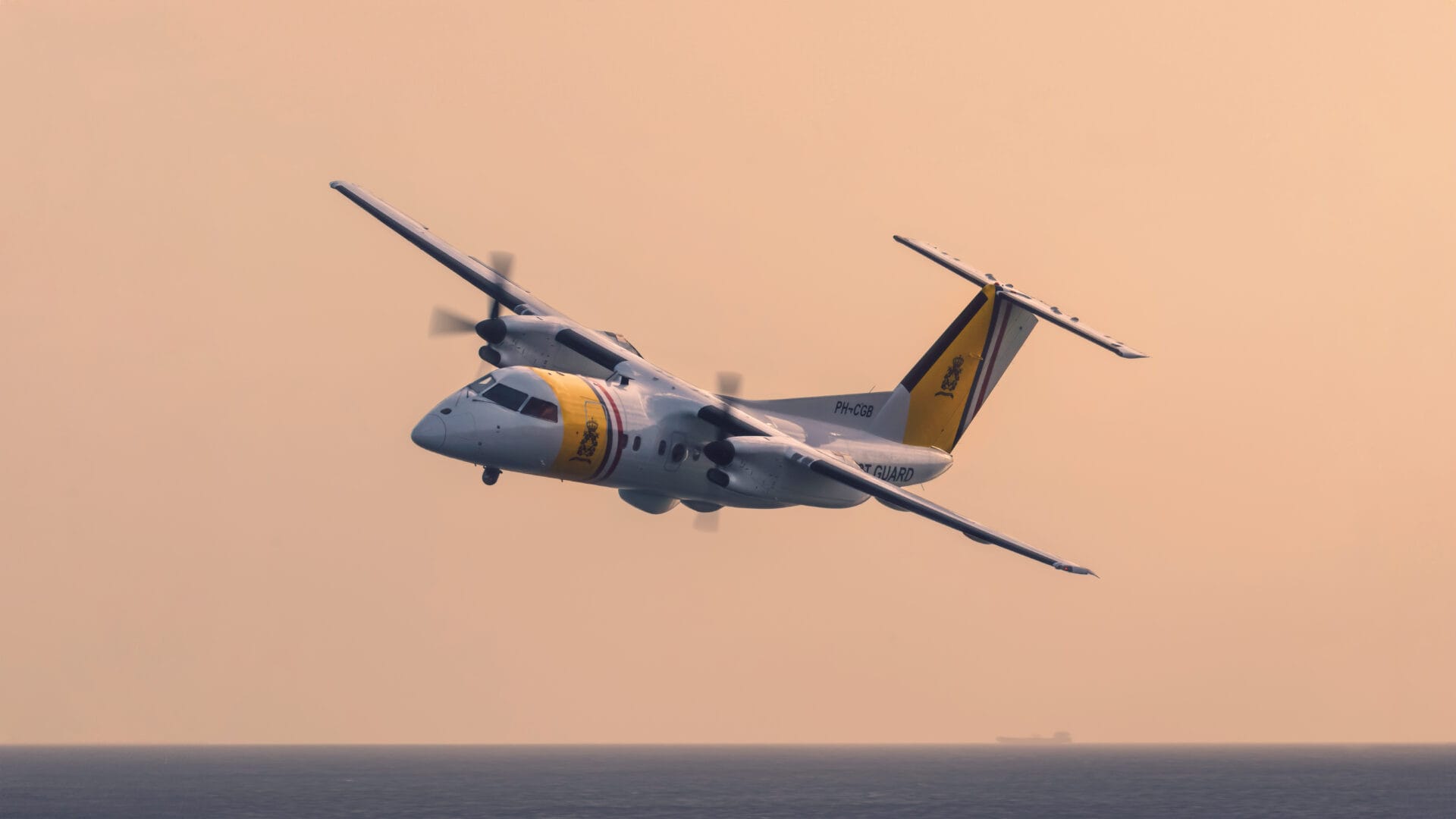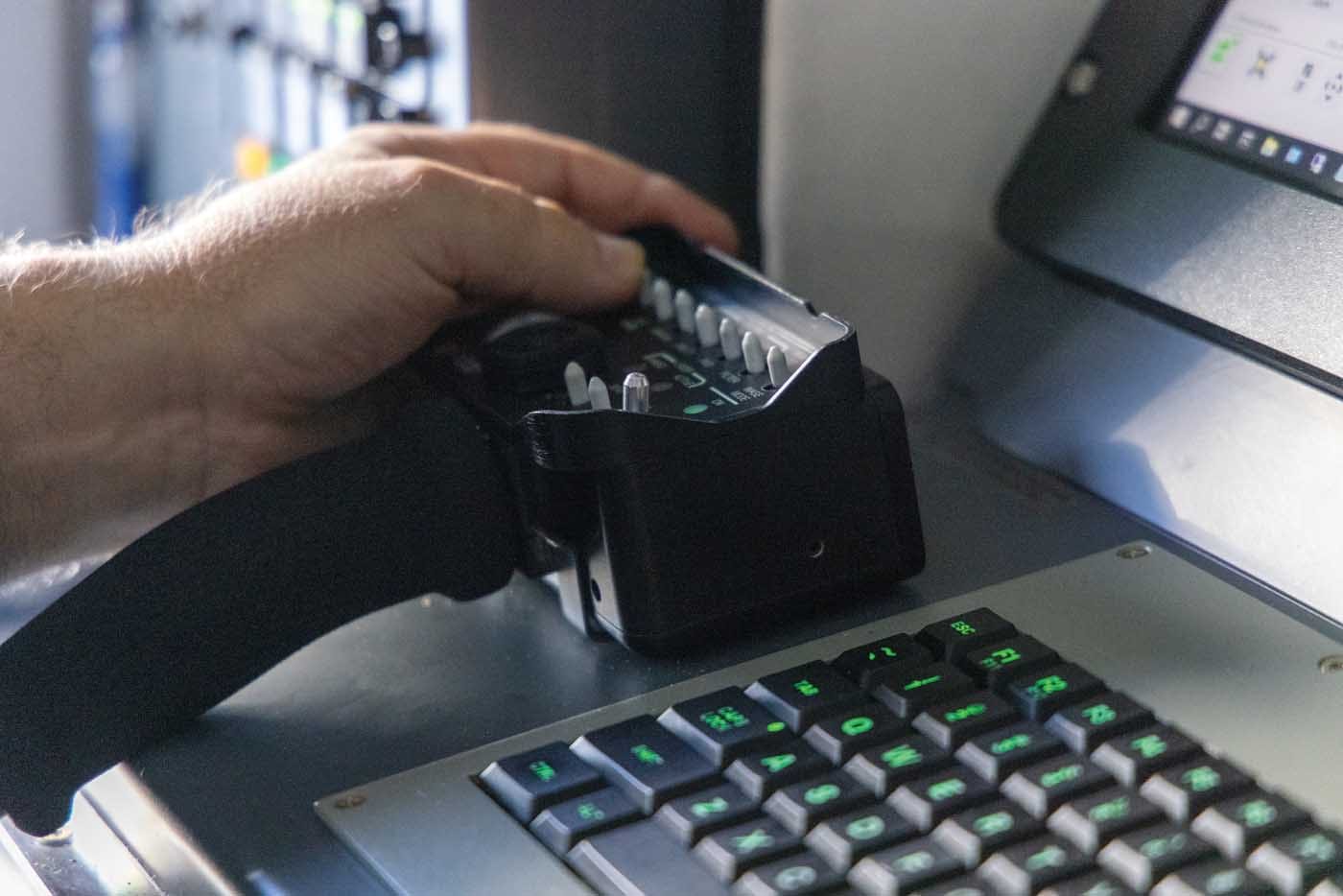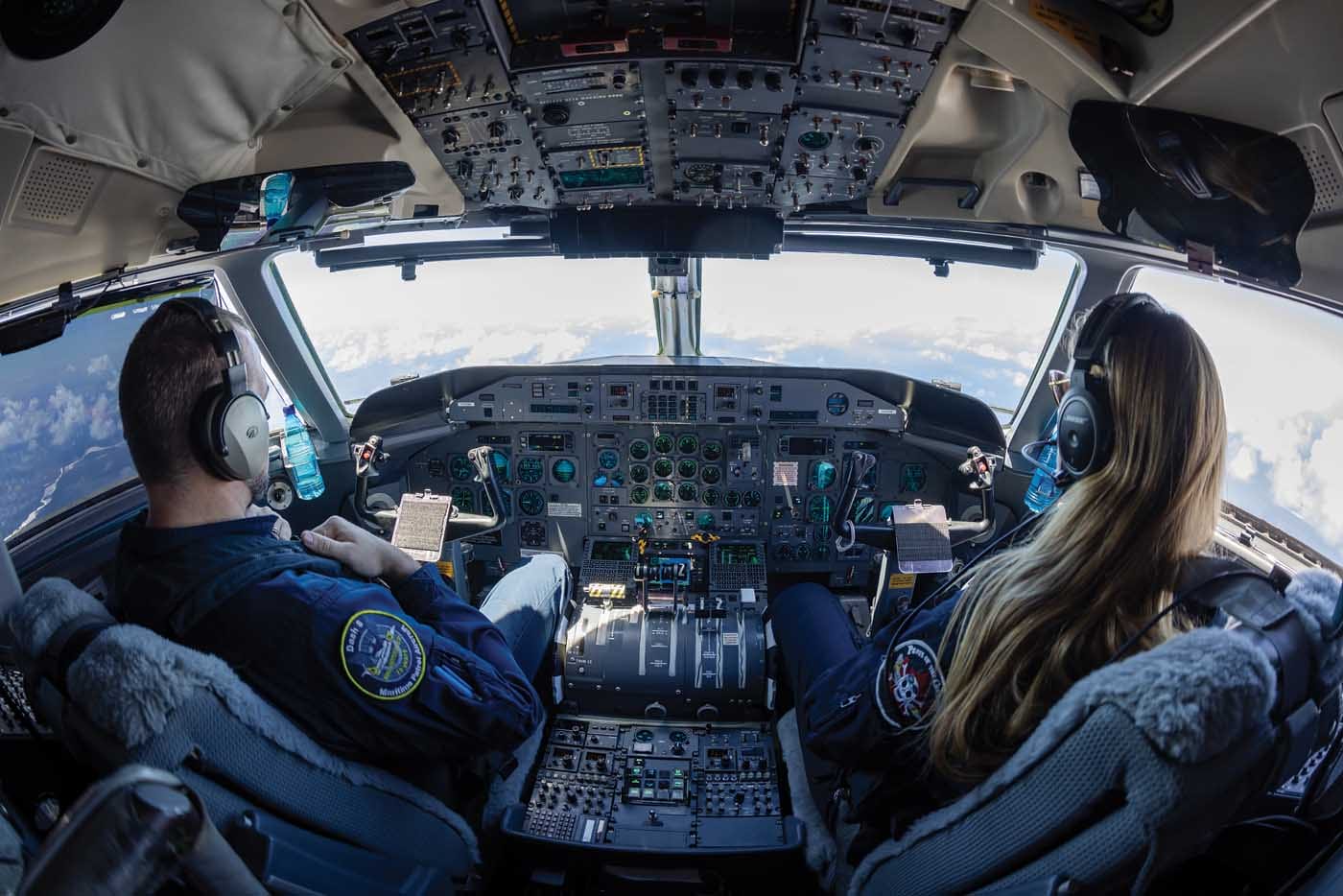WITH AN UPGRADED FLEET OF DASH 8s, PAL AEROSPACE HAS BECOME A CRITICAL PARTNER IN COUNTER-NARCOTICS AND OTHER MISSIONS ACROSS THE CARIBBEAN.
Adopted from Skies Magazine,
Story by Brent Bergan
Photos by Patrick Lalande
Original article posted: skiesmag.com
St. John’s, N.L., is geographically the most easterly city in North America, a full 1.5 hours ahead of Eastern Standard Time, jutting out into the frigid and harsh waters of the North Atlantic. For PAL Aerospace, the location is home base, and key to its success flying maritime operations. The company has provided maritime surveillance capabilities to the Department of Fisheries and Oceans since 1988, and has supported other departments and agencies, including the Canadian Coast Guard and the Department of National Defence, with search and rescue and maritime domain awareness.
From that perch in the Atlantic, PAL Aerospace has grown a global network of De Havilland Canada Dash 8s conducting multi-mission operations for governments, leveraging advanced sensors to provide intelligence, surveillance, and reconnaissance (ISR), maritime security, law enforcement, disaster response, and search and rescue.
Since 2007, PAL has provided a contractor owned, contractor operated service from Curaçao, supporting the Dutch Caribbean Coast Guard with two Dash 8-100 maritime surveillance aircraft and experienced crews, on call and ready to respond around the clock. In February, the company delivered the first of two upgraded, missionized Dash 8s to the small island, part of a contract renewal reaffirming its commitment into the next decade to provide maritime patrol.
Curaçao, just north of Venezuela, sits astride a strategic location for both oil refining and drug trafficking. The Dutch Caribbean Coast Guard finds itself in the heart of the traffic flow of thousands of tons of cocaine annually. The Caribbean corridor offers the cartels one of the more important maritime export pathways for a drug that moves primarily over the water.
PAL is a linchpin for the aviation response, and is often relied upon by the French Rescue Coordination Center (Le Centre Régional Opérationnel de Surveillance et de Sauvetage Antilles-Guyane, or CROSS-AG), and Joint Interagency Task Force South (JIATF-South), which falls under U.S. Southern Command and is responsible for all detection and monitoring in the Caribbean and Eastern Pacific.
Transnational criminal organizations transport about 3,000 metric tons of cocaine per year, according to RAdm Mark Fedor, director of JIATF-South. At around US$40,000 to US$50,000 per kilo, that adds up to about US$135 billion per year of illicit drugs globally. JIATF-South’s annual take is about 10 percent of that flow—in 2023, they seized 300 metric tons, worth over US$8 billion.
“The value of our international partners is absolutely critical,” said Fedor. U.S. assets are scarce and frequently pulled away for international operations, so support for drug seizures from partner nations is critical. He likened the policing of the maritime transit zones to having just five police cars for the entire continental U.S.
“That means our targeting process has to be ruthlessly efficient,” Fedor said. Before it launches an interdiction, JIATF-South assembles a targeting package from an intelligence picture that fuses
multiple sources of information. “Once we believe something’s out there, that’s when we launch those aircraft … to get some eyeballs on the target so that [we] can vector the ships.”
“They are critical,” said Fedor. “The Dutch bringing their contracted aircraft to the fight just augments everything else we’re trying to do.”
“The area of responsibility for the Caribbean region is vast,” noted Baron Smith, PAL’s Curaçao director of air operations since 2017, and chief pilot since 2014.
He has been flying operations from Curaçao since 2010 in support of the Dutch Caribbean Coast Guard and said that while PAL flies the entire Caribbean, there are typically two types of patrols: one covering the ABC islands of Aruba, Bonaire, and Curaçao, and the other covering the Triple S islands of St. Martin, Statia (also Sint Eustatius) and Saba.
SENSOR FUSION
PAL has flown for the Dutch Caribbean Coast Guard for 16 years. The company understood the mission thoroughly and, with input from the Coast Guard, what upgrades were needed to keep the Dash 8 fleet relevant for the complex mission set.
The goal was a modernized suite of fused sensors, integrated with the CarteNav AIMS-ISR 10 mission system software architecture, to make sense of the immense amount of data flowing to mission operators. “The mission commander can look at all these different sensors now, not as individual sensors, but as a common operating picture on a single mission management system,” Smith explained.
Once a target is located and fixed, “you can look at that target in so many different ways,” he said, whether it’s with ViDAR (Visual Detection and Ranging) or the stabilized cameras.
ANY SEARCH AND RESCUE OPERATOR WILL TELL YOU THAT
THE PROBABILITY OF DETECTION OF A
PERSON IN THE WATER IS VERY LOW.
BUT THIS NEW TECHNOLOGY IS A BIT
OF A GAME CHANGER FOR US.
The ViDAR from Sentient Vision Systems offers a new capability, an artificial intelligence (AI)-enabled sensor payload of multiple high resolution, full motion video cameras able to scan the water for targets in up to a sea state of six, equating to 3.5-metre (10-foot) seas and 25 knot winds.
Once a target is spotted, including persons in the water, the system snaps a photo and sends it to the AIMS-ISR mission system for the operator to view. The operator can then use the mission system to cross-cue the onboard optical turret to identify the object.
“Trying to find a person in the water in a high sea state is really difficult,” Smith observed. “Any search and rescue operator will tell you that the probability of detection of a person in the water is very low. But this new technology is a bit of a game changer for us. We’re really looking forward to using this piece of kit to find those people.”
Software upgrades to the Dash 8 radar system may also be game changing. Under the new contract, the radar has gone from analog to digital processing, allowing the aircraft to conduct missions at greater altitudes. This has significantly increased the true air speed—ground speed, essentially— and enabled the aircraft to cover more water and to remain covert longer to avoid counter detection by the narco traffickers.
PAL’s operators use a layered approach with their sensors when conducting surveillance. The sensor suite allows them to begin processing the maritime picture over 240 kilometres (150 miles) from a target of interest. The sensors with the greatest range will start to build a picture and as the aircraft closes the distance, other sensors will add greater fidelity, further building that common operating picture. As the Dash 8 approaches the area of operation (AOR), the sensor team can eliminate targets using tools within the AIMS mission system to develop a clearer picture of what’s in the AOR before they even begin searching and prioritizing those targets.
“Pulling all that together is really what makes these sensors work so well—just the ability for them to look at one picture with maps and overlays with every target on it,” said Smith.
INTERAGENCY COLLABORATION
Before 2021, there were a lot of air assets supporting the counter drug efforts in the Caribbean. U.S. Air Force reserve squadrons would fly Airborne Warning and Control System (AWACS) aircraft along with U.S. Navy P-3 Orion patrol platforms. As global threats have increased, however, the U.S. Department of Defense has withdrawn much of that capability for missions elsewhere. The PAL aircraft and crews are one of the few remaining assets covering this vast region on a regular basis.
The upgraded Dash 8 is perfectly suited to affect the end game—directing surface vessels and helicopters to make those drug busts, seizing tons of cocaine, or to affect a rescue. When PAL flies, the mission commander runs the show from the cabin, directing the mission like an NFL offensive coordinator. Patrick Lalande, a former Royal Canadian Air Force surveillance specialist, has been flying for over 20 years, focusing primarily on anti-submarine warfare and maritime operations. All his sensor operators have 10 to 20 years of ISR experience.
This knowledge has paid dividends. The Caribbean is a dynamic operational area, featuring multiple languages and operational cultures among the various partners who patrol the waters, including the Dutch Navy, U.S. Coast Guard, U.S. Navy, Royal Canadian Navy, French Navy, Dominican Republic Navy, and the many island defence forces.
When a PAL crew is launched, its mission is driven by an intelligence alert or by another asset on scene that is running low on gas or time and requires a dynamic hand off.
“The number one priority for me as mission commander is to locate the target, so once we’re airborne, it’s as fast as possible to the area,” Lalande explained. The array of sensors and the mission system provide what he called the RMP or recognized maritime picture. Using different overlays on the screen, he can quickly sort through non-relevant vessels to identify targets of interest. A typical interdiction might involve the U.S. Coast Guard launching a small boat or helicopter from its cutter. Based on the speed and direction of the target, or go-fast, and the Coast Guard assets, the system will help him plot an intercept course.
At times, in the pitching sea states of the Caribbean, detecting the go-fasts and other targets is a challenge. Sometimes, luck plays a role. The sensors can pick up a small gas can floating on the water 160 km away, Lalande noted, but “I’ve had many cases of flying along on a routine patrol, and it’s just looking out the window, and then, “Hey, a go-fast.”
The AI-enabled ViDAR system can help fill gaps when the radar can’t build that comprehensive picture in higher sea states or if it’s trying to detect objects made with non-ferrous metals. “Drug packages floating in the water are a big thing for us,” said Lalande, and the ViDAR and cross-cued stabilized cameras work well spotting and identifying those small targets.
The fused system “is a masterpiece,” he said.
FUTURE PROSPECTS
As the demand for complex ISR platforms continues to grow globally, business will continue to expand for PAL Aerospace. Smaller countries without the resources to acquire and support aircraft and other assets “need a one-stop shop,” noted Ben Boehm, senior executive. And that is a strength PAL can provide.
The company offers a four-in-one solution: It builds out and missionizes aircraft; it has the software company, CarteNav, for specific mission systems; it also has the ability to fully integrate sensors and mission suites; and it has the operators to fly and execute operations globally. It’s a level of commitment to mission success that has resulted in an impressive 99.8 per cent reliability record. On recent operations, PAL has flexed where needed to pull in additional advanced sensors through its CarteNav ownership to meet mission requirements. This adaptability will be critical as PAL continues to deliver complex, missionized aircraft such as Dash 8s, King Airs and, in the future, business jets. PAL holds over 6,000 supplemental type certificates for turboprop and jet aircraft.
Like many others in ISR operations, PAL’s future focus is on data. “Everything is about data right now; the recency of data and how do you get the data in real time no matter where the airplane is, no matter what the airplane is doing,” said Boehm. The company is currently working on extremely high data throughputs—more than 100 megabytes per second—using both line of sight and beyond line of sight systems.
Technological enhancements aside, PAL’s secret to success would appear to be its focus on the mission. “We kind of pride ourselves as just being part of the team,” said Smith. And the standards for that teamwork have been set very high in Curaçao. PAL’s crews have accumulated a vast knowledge of maritime operations, and their impact on missions in the Caribbean has been substantial. With extensive experience in both engineering and operations, along with the vertical integration of bespoke engineering needs, PAL will continue to be a leader in muti-mission maritime operations.
Brent Bergan recently retired from the U.S. Coast Guard following a 23 year career. He flew the MH-65 Dolphin for thirteen years, focusing on maritime search and rescue. He shifted into international affairs and conducted port security assessments in seven Latin American Countries. From there he was selected to be the Senior Defense Official in Costa Rica. He finished his career in USCG Intelligence, and now works in Business Development for Sentient Vision.
GO-FAST INTERDICTION
BY PATRICK LALANDE
“There they go, they’re running!”
Our PAL Aerospace crew of four—two pilots, a sensor operator and myself, the mission commander—had already had a long night. It suddenly got longer. A routine patrol of the southern Caribbean for the Dutch Caribbean Coast Guard (DCCG) turned into a high-speed chase of a “go-fast” suspected of carrying a large quantity of narcotics. This is common in this area, and aviation assets are key to interdiction efforts.
We had departed our base in Curaçao three hours earlier, when our radar operator had detected a small, fast-moving vessel heading north, just outside our assigned patrol box off Venezuela. Having seen this situation play out several times, I briefed the crew that I intended to get “eyes on” the vessel using the MX-15 Electro-Optics Infra-Red (EOIR) imaging system to confirm it was a suspect while remaining undetected.
I made radio calls to JIATF-S headquarters in Florida and passed on details about the target to the watch officer. We were informed a U.S. Coast Guard (USCG) cutter was being tasked to intercept the go-fast and would arrive on scene in a few hours’ time. Important details such as callsigns, radio frequencies, and the ship’s position and capabilities, were also briefed by JIATF-S watch officers.
We spent the next few hours tracking the go-fast on both radar and EOIR and ensuring that JIATF-S and the USCG cutter had its latest position, course, and speed. This information is critical to the intercept plan, so that the ship can be at the right place, at the right time.
By now, our crew was paying greater attention to the fuel situation. The USCG cutter was two hours away, the “endgame” phase would likely take over an hour, and we still had to fly home. It was going to be
close. It’s almost always this way as we deal with slow moving ships and vast distances. These operations take time, so the pilots and I worked out several options for maximizing our flight time.
The cutter closed the distance to the target, launched small boat interceptors with their law enforcement team on board, and deployed their helicopter. The HH-65 Dolphin helicopter was from the U.S. Coast Guard HITRON (Helicopter Interdiction Tactical Squadron) and carries a sharpshooter on board, who can disable the go-fast’s engines. I used our AIMS mission system’s range and bearing information to guide the boarding teams and the HH-65 to the target. The go-fast had been stationary for a few minutes, and the end was in sight.
Suddenly, the go-fast took off at high speed as the intercept team approached. The suspects began to dump packages of drugs overboard. I continued to vector the intercept boats toward the go-fast. The HH-65, chasing the go-fast at low altitude, received authorization to disable the go-fast’s outboard engines. I recorded everything on video, noted the location of the dumped packages, and directed our aircraft into a wide orbit. The sharpshooter brought the chase to an end. Disabled and surrounded, the go-fast’s crew surrendered to the boarding teams. I directed one of the interceptor boats, using our EOIR, to each package so it could be pulled out of the water.
We were now at “bingo” fuel and had to start the long flight back to Curaçao. Another maximum-endurance mission was almost over. It was a successful night, but we knew we would likely be doing it again the next day.
Patrick Lalande is a retired RCAF CP-140 Aurora crew member. He now flies as a Tactical Coordinator and Mission Commander with PAL Aerospace and the Dutch Caribbean Coast Guard.
Original article posted: skiesmag.com







